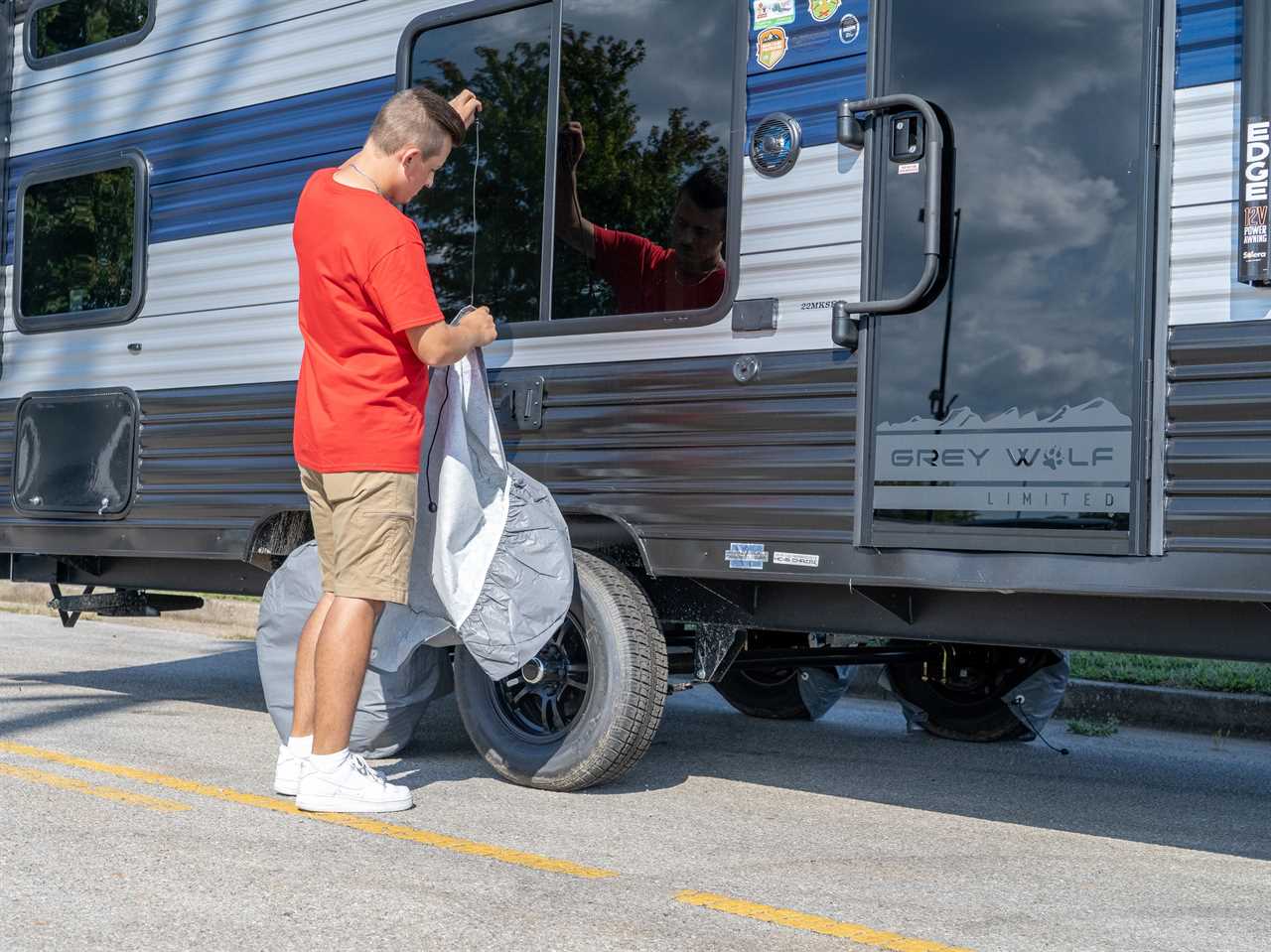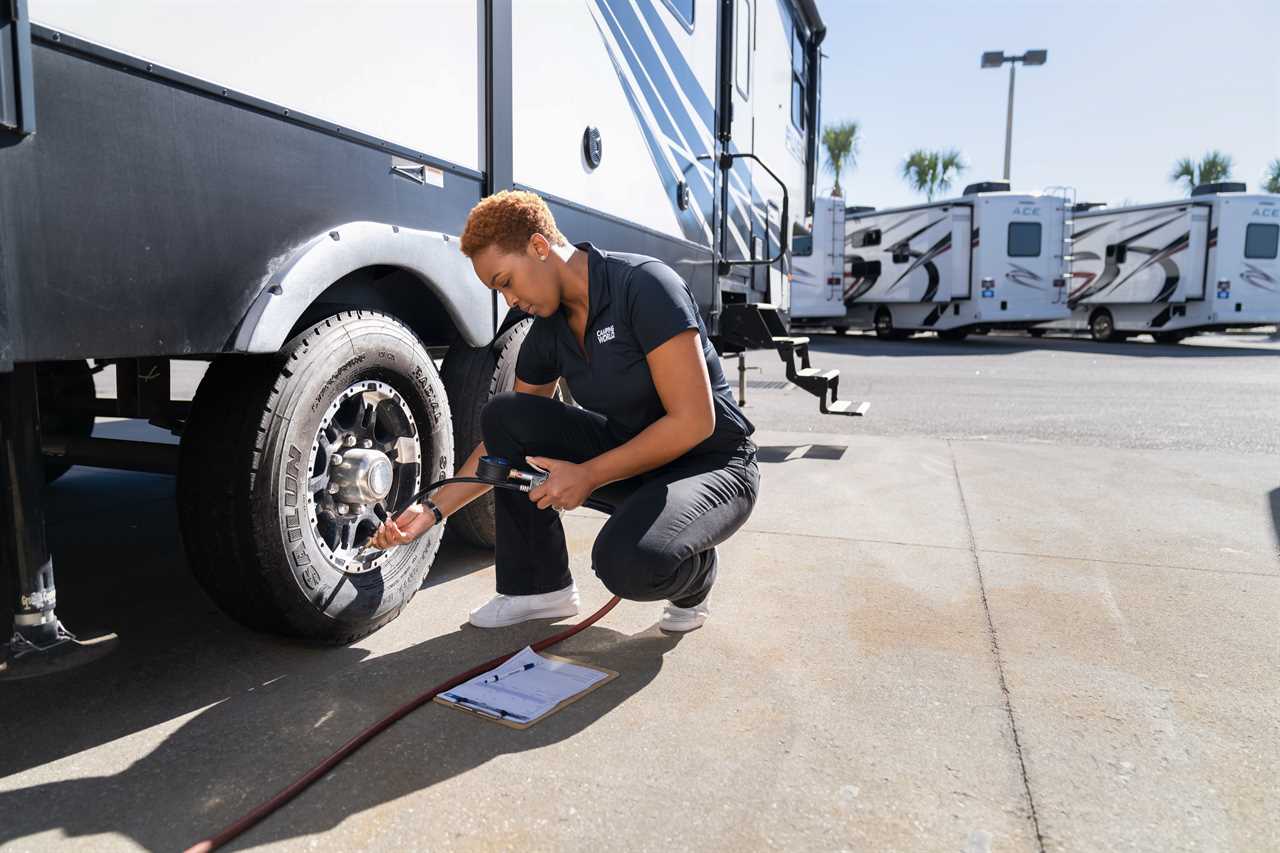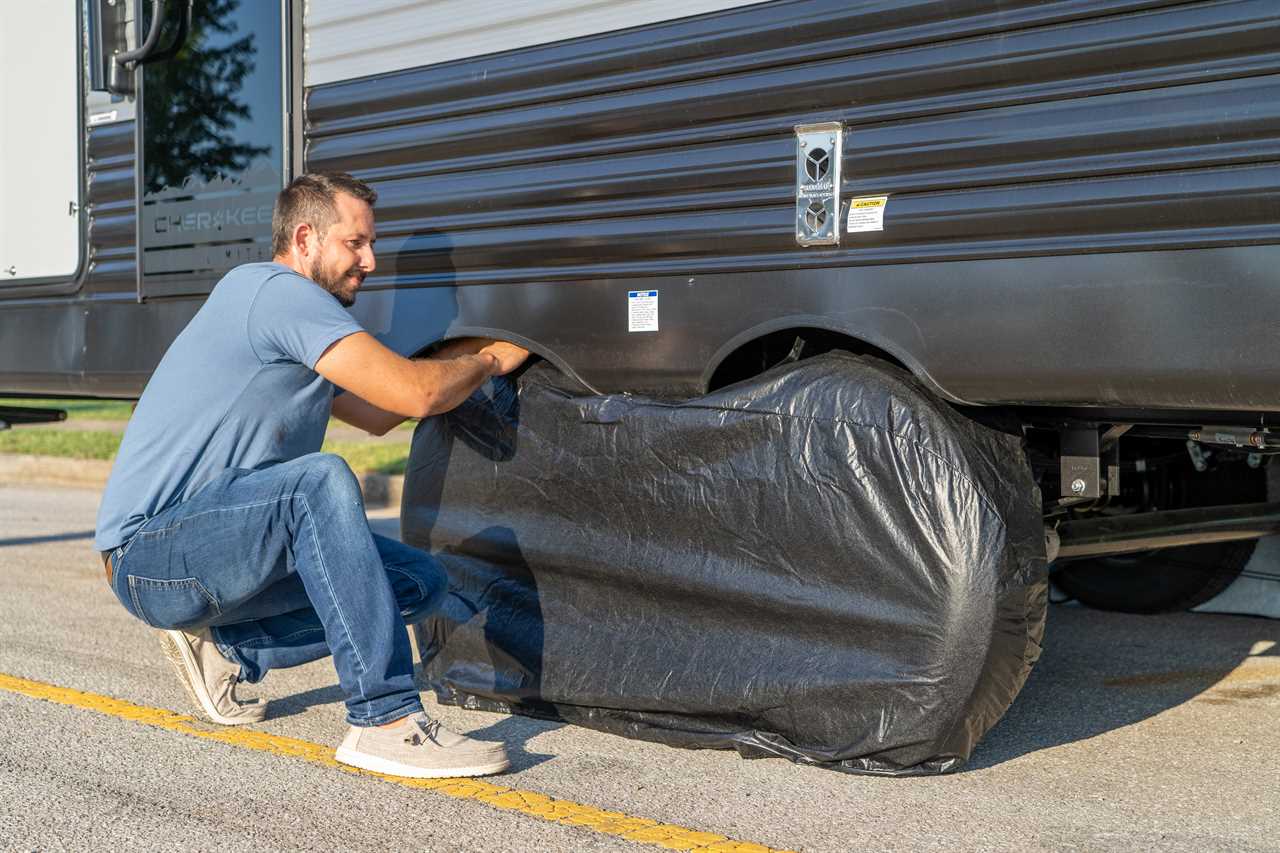Often an afterthought, tires are an integral part of your vehicle considering they are literally the only thing protecting your vehicle from the road, until they don’t — making it all the more important to find the ones that are best for your vehicle.
What kind of tire is best for your RV? Or what kind of tire is best for your car? How do you properly maintain your tires?
To help better prepare you for the hazards of the road, here’s a comprehensive guide to tires for cars and RVs.

Tires 101
Let’s start with a basic rundown of tire composition and everything you need to know about their features, and designs, as well as which is best for your vehicle.
Car tires
While there are several kinds of tires, each designed for specific driving conditions, we’ll break down some of the more common types.
All-season tires
Designed for a variety of driving conditions, including rain and light snow, all-season tires offer a good balance of performance, comfort, and durability, making them a popular choice for most cars.
Summer tires
As you can imagine, summer tires are perfect for warm weather and provide excellent handling and grip on dry roads. They have a softer rubber compound and a tread pattern that’s optimized for performance but are not recommended for cold or snowy conditions.
Winter tires
Also known as snow tires, winter tires live up to their name and have a special tread pattern, as well as a softer rubber compound, keeping them pliable and allowing for better rotation in cold, winter weather.
Performance Tires
Designed specifically for sports and luxury cars, performance tires offer superior handling, traction, and speed capabilities. With their unique tread pattern and high-performance rubber compound, they provide excellent handling and grip in wet and dry conditions.
All-terrain tires
All-terrain tires were created with the purpose of off-roading, giving them incredible traction even on rougher terrain. With a tougher sidewall and aggressive tread pattern, these tires can withstand higher impacts and more punctures than most.
Run-flat tires
Perfect for emergency situations, run-flat tires were created to continue driving even after a blowout, due to their reinforced sidewalls. They can support the full weight of a car with no air pressure, buying you time to safely find the next available repair shop.
RV tires
While the function of RV tires remains the same, they are understandably more durable and have slightly different designs. Here’s what you should know.
ST and LT
When it comes to RV tires there are two types you’ll want to familiarize yourself with: Special Trailer (ST) and Light Truck (LT). And while they look similar, they have very different functionality.
With a sidewall stronger than a normal truck or car, ST tires were designed specifically for trailers. They have a higher load capacity and can take on the stress of lateral forces while driving, allowing them to improve handling and reduce any trailer sway.
LT tires were designed for class A, B, and C rigs, offering excellent handling and stability, and have a stiff sidewall allowing them to provide more support even while carrying heavy loads.
Radial and bias
Let’s get a little more granular and discern the difference between radial-ply and bias-ply tires.
Radial-ply are constructed with cords that run perpendicular to the direction of travel (or radially), allowing the tire to flex more and provide a substantially smoother ride, along with better handling. You’ll generally find radial tires on newer RVs and passenger vehicles.
Bias-ply tires have cords that run at an angle towards the direction of travel, resulting in a stiffer sidewall making the tire more durable and better resistant to punctures or impacts. Bias tires are a little more common on older RVs, off-roading vehicles, and heavy-duty rigs.
But the real tradeoff is in lifespan and use, as while a bias tire can handle heavy loads, they will only last for about 12,000 miles (or 3 to 5 years). Radial tires, on the other hand, can go over 3x further and are a better fit for smaller RVs.
Reading the tire sidewall
While you can’t necessarily judge a book by its cover, you can gague a tire by it’s sidewall. The numbers may initially seem incoherent, but there’s a methodology to them that explains the size, load capacity, and what the proper inflation should be. Here are few things to consider.
Tire size
The size of your tire is indicated by a series of numbers on the sidewall of the tire. The first number indicates the width of the tire (in millimeters), the second number shows the aspect ratio (height of the sidewall as a percentage of the width), and the third number will let you know the diameter of the rim (in inches).
For example, if you saw something like P220/70R17 you would be able to translate that the width is 220mm, the aspect ratio is equal to 70%, and the diameter is 17”.
Load range
The load range indicates just how much weight the tire can carry safely. This number should be written in both kilograms as well as pounds.
Tire pressure
Maintaining the correct tire pressure is crucial because underinflated tires can lead to damage to the fender skirts and wheel wells, as well as cause excessive heat buildup leading to a blowout. Overinflated tires can cause a rough ride as well as uneven tire wear. Make sure you have a trustworthy tire pressure gauge, and if you have a vehicle with dual rear wheels, you’ll want to make sure you have a gauge with an offset double head capable of reaching the inner and outer valves.
The correct tire pressure can be found on the sidewall written out in pounds per square inch (psi), as well as in the owner’s manual or on a sticker located on the vehicle near the driver’s seat.
Temperature and altitude
Extreme temperatures can directly affect the performance of your tires. Hotter weather will cause the air inside the tire to expand, potentially leading to over-inflation and an increased risk of a blowout; while cooler temperatures will cause the air inside the tire to contract, leaving to under-inflation as well as reduced handling.
Altitude can affect the weight capacity of your tires, and higher elevations will quickly decrease your tire’s capacity. As you plan trips with higher elevations, it’s critical that your tires are rated for the weight of your vehicle, as well as any gear or supplies you may be hauling.
Nitrogen and oxygen
When it comes to filling up your tires, you have the option of using either oxygen or nitrogen. Oxygen tends to be more common and can be found at most gas stations or auto shops. Obviously, it’s safe to use, but it’s not without its limits. Oxygen contains moisture which can cause rust and corrosion over time. Plus, it can also oxidize and degrade the rubber of the tire prematurely.
Nitrogen, on the other hand, has a lower rate of pressure loss, reduced risk of rust and corrosion, as well as no oxidation. Nitrogen is also a little more stable even with varying temperatures, reducing fluctuations with inflation, making it a viable, albeit more expensive option.
While nitrogen has a number of advantages over oxygen, it’s still essential to regularly check the pressure and condition of your tires.
Wheels
RV wheels are typically made of steel or aluminum, with steel wheels being the heavier and cheaper option, while aluminum wheels are lighter and more expensive.
It’s important to note that while wheels might feel like an afterthought compared to tires, maintenance is still vital. Compromised, worn, or damaged rims can cause dangerous tire blowouts, leading to serious accidents. If your wheel is damaged by a road hazard and can’t maintain an airtight seal, the tire can’t be balanced. Or even if the breaking and handling feels off, you’ll want to bring your vehicle in and get it checked out.

Maintainance dos and don’ts
Once you’ve identified the right type of tire for your vehicle, take proper care to get the most out of your tire’s life. Here are a few maintenance dos and don’ts.
Regularly inspect your tires
Regular inspections are crucial for safety and performance. Take time at least once a month or before a long trip, to check the pressure and tread, as well as look for any punctures, cracks, or uneven wear to reduce the risk of a blowout or accident.
Rotate your tires regularly
Get more life out of your tires and rotate them every 5,000 to 7,500 miles. Your tires wear down differently depending on where they’re positioned, and your front tires will naturally bear more weight and pressure during turns and brakes. By rotating your tires regularly, you can redistribute the wear and tear, and allow each tire to age at about the same rate. Not to mention this will also increase your fuel efficiency over time.
Keep your tires inflated
Proper inflation is vital to the integrity of your tires and can directly correlate with their longevity. An underinflated tire will flex more when exposed to the road and therefore generate heat leading to premature wear and tear, decreased fuel efficiency, as well reduced handling and braking. Conversely, an overinflated tire has less surface area in contact with the road, leading to less traction and stability, as well as a higher risk of a blowout.
Get an alignment
Over time, your vehicle will become susceptible to natural conditions (potholes, curbs, etc.) and will require an alignment to ensure its safety and handling, as well as your tires’ longevity. Basically, alignment refers to adjusting the angles of the wheels to match the manufacturer’s specs. It’s recommended to bring your vehicle in every 12,000 miles or at the first sign of misalignment.
Tire storage
If you’re winterizing your vehicle or trying to store a spare, make sure the tires are clean and stored indoors in an environment that’s free from any grease, gas, moisture, or sunlight. If you have to store them outdoors, try and keep them off the ground with a waterproof cover.
Know when to replace
The general rule is to replace your tires every six years, as the rubber will naturally deteriorate over time, compromising their performance. That being said, if your tires are looking bald and worn down, or showing signs of damage (cracks, cuts, bulges, or punctures), it’s probably time to get them replaced.
Replacing a flat
While the hope of this article is to help you avoid any issues, flats can still happen. In the off-chance you find yourself in a precarious situation, here are a few things to remember.
- Find a safe and flat area to change the tire.
- Engage the emergency break.
- Locate the spare tire, jack, and lug wrench in your vehicle.
- Use the lug wrench to loosen the lug nuts on the flat tire – but don’t remove them yet.
- Place the jack under the vehicle at a recommended point (refer to your manual for the precise location).
- Remove the lug nuts and pull the flat tire off the hub.
- Mount the spare tire onto the hub and hand-tighten the lug nuts.
- Lower the vehicle until the spare tire is touching the ground, but not bearing its full weight.
- Use the lug wrench to tighten the lug nuts as much as possible, going from one lug nut to the opposite one as if in the pattern of a star.
- Lower the vehicle completely and remove the jack.
- Use the lug wrench to tighten the lug nuts again in the same star-type pattern. Make sure they’re snug.
- Check the spare tire’s pressure and inflate it appropriately.
- Safely drive your vehicle to the nearest shop or service center to replace the spare.

Make sure you’re covered
Despite the best of intentions, accidents happen. The good news is that Good Sam offers up to 5 years of tire and wheel coverage without breaking the bank. With the best nationwide coverage on tires and wheels, they’ll get you back on the road quicker. It’s road hazard coverage that won’t leave you flat.
The post The Tire Forecast: A Comprehensive Guide to Tires for Cars and RVs appeared first on Good Sam Camping Blog.
By: Sean Richards
Title: The Tire Forecast: A Comprehensive Guide to Tires for Cars and RVs
Sourced From: blog.goodsam.com/guide-to-tires/
Published Date: Sun, 26 Mar 2023 17:09:36 +0000
---------------------------------------------
Did you miss our previous article...
https://outdoorsnewswire.com/camping/
 CampingSurvivalistHuntingFishingExploringHikingPrivacy PolicyTerms And Conditions
CampingSurvivalistHuntingFishingExploringHikingPrivacy PolicyTerms And Conditions
